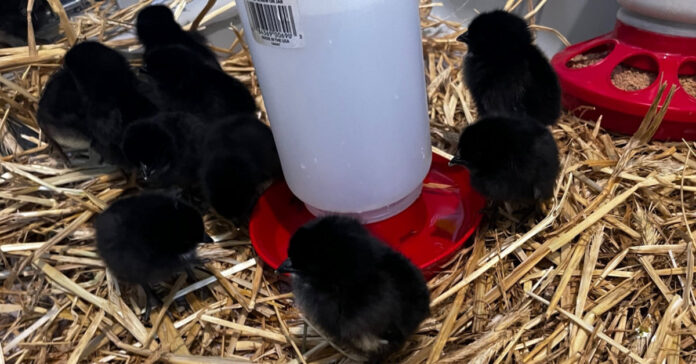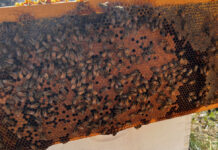When we first got chicks two years ago, they quickly became big attention getters. We would check in on them frequently, watch them run around, and pick them up and coo at them like we were talking to a baby. This time around, they aren’t quite as exciting.
Don’t get me wrong, we are still taking good care of them. Their brooder is keeping them warm and they have plenty of food and water. Because this is not our first time, the excitement factor is much lower. Now they are just another chore. Changing the bedding is the biggest chore of all.
“We gotta change the bedding in the brooder.”
“Again? Can’t we wait until tomorrow?”
Shrug. “Yeah, I guess so.”
At least none of them have suffered from pasty butt yet.
Rapid Growth
At first, when we would walk by, the chicks would run under cover and huddle together. Now they are used to us. The dog has even visited, peering through the cage. She seems curious, but not in an “I bet I could eat one of those!” way.
I had forgotten how quickly the little fuzzballs grow, and it is no wonder because they do little other than eat and poop. They arrived less than 48 hours after being born and tottered around the brooder, spending most of the time huddled beneath the heat panel but venturing out to eat. When we went to change the bedding at the end of the first week, they were already trying to fly out when we removed the lid. They had doubled in size. Now, a week later, they are even larger and have clearly defined necks. As a result, they look more like runner ducks than chickens.
It’s going to be tough to keep them from escaping when we change the bedding the next time. The last thing we need is a tiny chicken running around the cluttered garage. I can imagine one getting caught in a mouse trap.
During a recent power outage, we filled gallon jugs with hot water and placed them in the brooder to keep the chicks warm. The outage only lasted four hours, so the heat panel warmed up again and we didn’t have to worry about changing their water every couple of hours through the night. That may have been a downside about buying chicks earlier this time.
Weather
My plan had been to get the chicks six weeks before June 1, so we could put in the chicken coop and run in early June. That timing is on track; the question is if the weather will cooperate. We have to see how they feather out and how cold it is in early June. So far, spring has been cool and damp.
For example, I have yet to remove the solid plastic from the chicken coop windows because the nights can get down into the 30s. The spinach we direct seeded in the garden hasn’t come up yet, and spinach is a cool weather crop that is often grown early in the spring. Besides a few odd beans, the radishes are the best crop to date. Figures. I am not a huge fan of radishes.
After a couple weeks in which we could get by without using the wood stove, we had to fire it up for about 72 hours and then a few days later it was so windy and wet, we did so again. Yes, we have burned wood for heat in May, which means we burn wood at least eight months a year.
It is 64°F in my office as I write this, and the dampness from recent rain makes it feel even colder. I am, I admit, tempted to light a fire.
The best thing about using wood heat in the spring is that six pieces of wood will generate at least eight hours of warmth, which is just right for an evening. When we start the fire after dinner, the thermometer pops up to 67° or 68° and slowly climbs from there, but it doesn’t reach 73° like it does when we let the fire burn for hours. Still, 67° is a noticeable improvement over 64°. Those three or four degrees make a big difference.
Eggs
Our existing chickens have not yet reached their previous heights of egg laying and, because of their advancing age of two, we are not sure they ever will. We are maxing out at eight eggs a day from 11 hens, and some days as few as five. This is reducing my egg money and we have to pick and choose which customers get eggs which week.
These new chicks won’t be laying hens until September, but we have high hopes for them. With any luck, they will lay non-stop all winter.
We had purchased 12 chicks and gave four to friends. This allowed us to share the shipping cost. Curiously, we still had 10 chicks left. Apparently, someone at Murray McMurray hatchery lost count when plopping our chickens into the shipping box and we received 14. This means more eggs for us, but also higher consumption of feed. And we may have to cull a few more than we expected come fall.
We haven’t lost a chick yet, but just in case, I jokingly say we have an heir and a spare.







